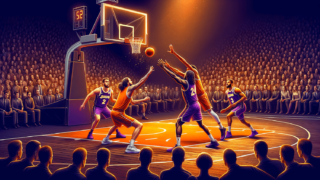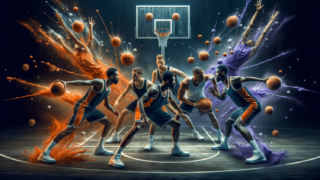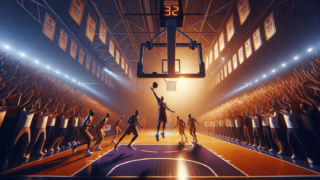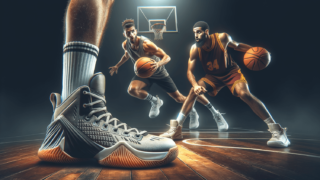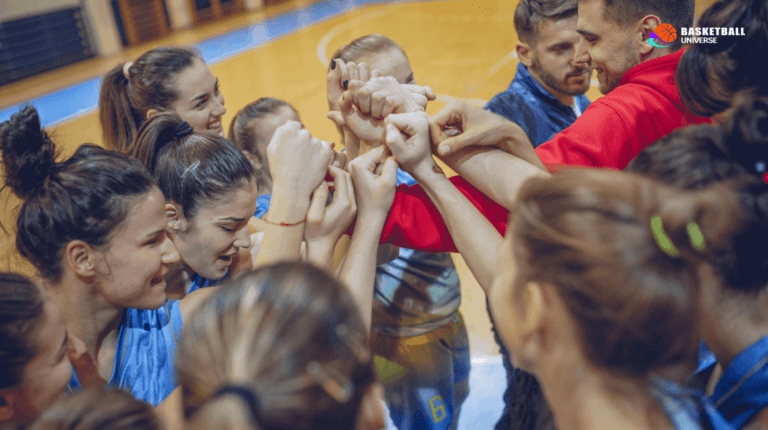
What’s a Turnover in Basketball?
Written by: Basketball Universe
Last updated:

Turnovers, turnovers, turnovers! The bane of every basketball player’s existence, yet an indispensable element of the game. Welcome to our detailed exploration of the perplexing world of basketball turnovers! In this fun and informative blog post, you’ll come to understand what a turnover is, how it impacts the game, and ways teams and athletes can minimize these errors for optimal performance. So, lace up your sneakers, warm up your dribbling fingers, and let’s dive headlong into the mesmerizing intricacies of “What’s a Turnover in Basketball?!
What’s a Turnover in Basketball?
A turnover in basketball occurs when a player from one team loses possession of the ball to the opposing team, either through an offensive mistake, violation, or a defensive action. Turnovers can happen in various ways, such as bad passes, offensive fouls, traveling, double dribble, or the ball going out of bounds. They are a crucial aspect of the game because minimizing turnovers helps maintain possession and increase scoring opportunities, while forcing turnovers through strong defense can boost a team’s chances of winning.
Dissecting the Different Types of Turnovers in Basketball
If there’s one thing we can all agree on, it’s that turnovers come in many shapes and sizes. Let’s delve into the various types of turnovers and explore some examples to better understand this game-changing aspect of basketball.
Bad Passes
Whether it’s a miscommunication between teammates, a poorly-executed pass, or an incredible defensive play by the opposition, bad passes often lead to turnovers. Improving communication, awareness, and timing on the court can help to reduce the number of bad-pass turnovers.
Steals
Steals happen when a defensive player snatches the ball away from an offensive player, either by intercepting a pass or knocking the ball loose from the dribble. Being proactive in protecting the ball, strengthening your ball-handling skills, and making smart passes will minimize the chances of a steal.
Travelling and Double Dribble
Travelling and double dribble are two types of ball-handling violations that result in turnovers. Travelling occurs when a player holding the ball takes multiple steps without dribbling, while double dribble happens when a player stops his dribble and starts dribbling again or dribbles with both hands simultaneously. Adequate coaching and practice will help refine players’ dribbling techniques, making them less susceptible to these violations.
Out of Bounds
An out-of-bounds turnover takes place when a player in possession of the ball steps over the sideline, baseline, or passes the ball to a teammate who is out-of-bounds. Increasing court awareness, practicing proper foot placement, and becoming accustomed to the court dimensions help players avoid the dreaded out-of-bounds turnover.
Offensive Fouls
Offensive fouls are a critical kind of turnover that includes actions like illegal screens, charging, offensive goaltending, and pushing off. Being aware of your body movements, maintaining control on the court, and recognizing defensive players’ positions can help reduce the occurrence of offensive fouls.
The Impact of Turnovers on the Game
Turnovers can make or break a basketball game. Winning the turnover battle, which means committing fewer turnovers than your opponent, can be a significant key to victory. Let’s discuss some ways turnovers influence the game:
Impact on Possession and Scoring Opportunities
When a team commits a turnover, they lose possession and provide their opponents with a potential scoring opportunity. Minimizing turnovers helps maintain possession, which, in turn, increases your team’s chances of scoring. More possession time also means your team gets more shots and rebounds while limiting the opposing team’s opportunities to score.
Effect on Game Tempo and Momentum
Turnovers can disrupt the flow of a game and shift the momentum in favor of the team that forces them. A flurry of turnovers might frustrate the team committing errors and demoralize players, leading to a loss of rhythm on both offense and defense. By contrast, taking advantage of turnovers boosts the morale and confidence of the team forcing the mistakes.
Impact on Defensive Strategy
Forcing turnovers is an essential part of defensive strategy in basketball. A well-coached team may change defensive tactics throughout a game to create more turnovers, such as employing full-court press, more aggressive trapping, or employing zone defenses that are designed to create deflections and interceptions.
Reducing Turnovers: Tips and Strategies
To reduce turnovers and ultimately strengthen your basketball performance, follow these helpful tips and strategies:
Improve Ball-Handling and Passing Skills
Developing proper ball-handling and passing skills through practice can reduce the risk of turnovers. Focus on dribbling with either hand, timing and accuracy of passes, and using various passes like bounce, chest, and overhead passes. Practicing these skills under pressure will help you maintain composure during actual games, further reducing turnovers.
Maintain Good Court Vision
Having good court vision enhances your ability to make better decisions on the court. Keep your head up, scan the court to recognize open teammates, monitor your defenders, and spot potential dangers. This will help you avoid forced passes, bad decisions, and miscommunications that may lead to turnovers.
Develop Better Communication
Effective communication on the court is paramount. Talk to your teammates, call out plays, discuss possible screens, and express intentions clearly. Good communication results in better teamwork, enhanced efficiency on the court, and a decrease in avoidable turnovers.
Learn from Mistakes
It’s crucial to learn from your mistakes and analyze the situations that led to turnovers. Review game tapes, discuss areas of improvement with your coach, and work on weaknesses during practice. This will help you recognize patterns and prevent repeating the same mistakes in future games.
Key Statistics: Measuring the Importance of Turnovers
To emphasize the significance of turnovers in basketball, let’s take a look at some key statistics used to measure their impact on a team’s performance:
Turnover Ratio
Turnover ratio, often denoted as TOV% or TO%, is calculated by dividing the number of turnovers by the total possessions a team has. This percentage measures the frequency of turnovers in relation to the number of possessions. A lower turnover ratio is more desirable since it shows that a team commits relatively fewer turnovers per possession.
Points off Turnovers
Points off turnovers (POT) is a measure of how many points are scored by a team as a direct result of their opponents’ turnovers. A high POT shows that a team is capitalizing on their opponents’ mistakes, which can be the difference between victory and defeat in close games.
Turnovers per Game
Turnovers per game (TOPG) is a straightforward statistic that calculates the average number of turnovers a team commits in each game. Comparing TOPG between teams can provide insight into their ball-handling efficiency and the effectiveness of their defensive pressure.
Historic Turnover Records: The Good, the Bad, and the Ugly
Let’s take a trip down memory lane and explore some historic basketball turnover records. These records highlight the best and the worst turnover performances in the world of professional basketball:
Record-Setting Steals: The Good
On December 9, 1978, Larry Steele of the Portland Trail Blazers achieved a memorable milestone by forcing 10 steals, setting the NBA record for the most steals by an individual in a single game (a record shared with Kendall Gill). It was a prime example of how great defense can lead to numerous turnovers and ultimately make an indelible mark on the game.
Turnover Troubles: The Bad and the Ugly
On the flip side, the ignominious record for the most turnovers committed by a team in a single game goes to the San Francisco Warriors. On November 13, 1971, they committed 45 turnovers in a game against the Los Angeles Lakers, a record that still stands today as a stark reminder of the havoc turnovers can wreak on a team’s performance.
Turnovers: A Crucial Component of Basketball
As we’ve discovered, turnovers are an integral yet often overlooked aspect of basketball. Not only do turnovers have the power to dictate the outcome of a game, but they also provide valuable lessons and insights for both individual players and teams as a whole. By developing technical skills, enhancing court awareness, and improving communication, basketball players can minimize the impact of turnovers and elevate their game to the next level.
Turnovers and Basketball Greats
Even the most skillful basketball players battle with turnovers throughout their careers. Yet, these unique experiences often help refine their skills and elevate their game. In this section, we’ll examine how turnovers have impacted some standout players in the history of basketball.
Michael Jordan: Overcoming Turnovers
Arguably the greatest basketball player of all time, Michael Jordan struggled with turnovers early in his career. In fact, during his rookie season (1984-85), he averaged 3.5 turnovers per game. Through hard work and dedication, Jordan reduced his turnover numbers significantly over the years, averaging a career-low 2.0 turnovers per game during the 1995-96 season. This improvement showcases how even elite players must overcome issues with turnovers to achieve their full potential.
Jason Kidd: Balancing Assists and Turnovers
Journeying back to the heyday of Jason Kidd, the Hall of Fame point guard was revered for his exceptional passing and court vision. However, along with his assist highlights came a fair share of turnovers. Kidd focused on minimizing turnovers while maintaining his aggressive playmaking style. Striking this balance throughout his career paved his pathway to impressive successes, including an NBA championship and two Olympic gold medals.
The Role of Coaching in Reducing Turnovers
Coaches play a crucial role in reducing the number of turnovers a team commits. Let’s discuss how coaching strategies impact turnovers and the development of basketball players.
Implementing Effective Drills
Designing tailor-made practices and drills that work on ball-handling, passing, and decision-making under pressure helps players to better manage turnovers during games. Coaches constantly evaluate their team’s performance and identify specific areas where improvement is needed to minimize turnovers.
Scouting Opposing Teams
Understanding the strengths and weaknesses of opposing teams can help coaches devise strategies to reduce turnovers. Scouting reports provide valuable information about the opposition’s defensive tendencies, which can be used to prepare players for potentially challenging scenarios and situations. This preparation can lead to better decision-making and fewer turnovers for your team.
Creating Turnover-Conscious Game Plans
Coaches who develop game plans that prioritize ball security set their teams up for success by mitigating the risk of turnovers. These plans might emphasize making smart passes, focusing on high-percentage plays, and elaborately outlining each player’s role and responsibilities within the offensive system. By following a turnover-conscious game plan, players learn how to value each possession and avoid costly mistakes.
FAQ: Frequently Asked Questions About Turnovers in Basketball
Take a deep dive into your understanding of turnovers with this FAQ section that covers some common questions related to the all-important basketball concept. From reducing turnovers to their impact on the game, we’ve got you covered!
1. What causes the most turnovers in basketball?
Turnovers in basketball can result from a variety of factors. However, the most common turnovers usually stem from bad passes, offensive fouls, ball-handling violations like travelling or double dribbling, or losing the ball out of bounds. Effective communication, solid ball-handling skills, and good decision-making can help reduce these turnovers.
2. How can I improve my ball-handling to prevent turnovers?
To enhance your ball-handling and prevent turnovers, focus on developing your dribbling skills with both hands, maintaining proper stance and footwork, and protecting the ball from defenders. Practicing under pressure and performing various ball-handling drills will help you improve your skills and feel more comfortable on the court.
3. What basketball drill can help me with my turnover issue?
There are numerous basketball drills designed to help with turnovers. A popular and effective one is the “two-ball dribbling drill.” In this drill, a player dribbles two basketballs simultaneously while incorporating various dribbling moves. This exercise helps improve ball-handling, coordination, and confidence, all of which contribute to reducing turnovers.
4. Are turnovers equally important for guards and forwards?
While turnovers can impact the game for all positions, guards–particularly point guards–should pay extra attention to minimizing them, as they generally handle the ball more often and are responsible for initiating the team’s offense. However, all players should strive to reduce turnovers to maximize their team’s performance collectively.
5. Can turnovers have a positive impact on the game?
Yes, turnovers can have a positive impact on the game for the team forcing the turnover. As turnovers often provide additional scoring opportunities and disrupt the flow of the opposition’s offense, a strong defensive team that forces numerous turnovers can shift momentum in their favor and increase their chances of winning.
6. How do turnovers affect team chemistry?
Turnovers can negatively impact team chemistry if players become frustrated and lose confidence in one another. Good communication and mutual support are essential for overcoming this issue and maintaining a positive team dynamic.
7. How does a defensive team capitalize on turnovers?
A defensive team can capitalize on turnovers by converting them into fast-break opportunities, pushing the tempo, and taking advantage of mismatches or disarray in the opposing team’s defense. High awareness and quick decision-making help a defensive team seize these opportunities.
8. What’s the record for the most turnovers in an NBA game?
The record for the most turnovers committed by a single team in an NBA game is 45, set by the San Francisco Warriors against the Los Angeles Lakers on November 13, 1971.
9. How can I reduce turnovers as a point guard?
To minimize turnovers as a point guard, work on developing sound ball-handling and passing skills, good court vision, effective communication, and smart decision-making. Practicing under pressure and reviewing game footage to learn from past mistakes will also contribute to turnover reduction.
10. How does a coach help minimize turnovers in a team?
A coach can help minimize turnovers by implementing effective drills targeting ball-handling, passing, and decision-making; scouting opponent teams to understand their defensive tendencies; and developing game plans with an emphasis on ball security and specific player roles and responsibilities.
11. Are all turnovers the result of mistakes by the offensive team?
Not all turnovers are due to offensive mistakes. Defensive teams can make extraordinary plays to force turnovers, such as intercepting passes, pressuring ball-handlers into errors, or blocking shots. Nonetheless, reducing offensive mistakes will still help minimize the overall number of turnovers.
12. How does Luka Doncic’s turnover rate compare to other NBA players?
Luka Doncic, the talented Dallas Mavericks guard, has averaged around 4 turnovers per game during the initial seasons of his career. While his turnover rate might be considered high, it’s essential to consider his high usage rate, ball-handling duties, and playmaking responsibilities when evaluating his overall performance.
13. How do professional leagues measure turnovers in relation to possessions?
Turnover ratio (TOV% or
Featured Posts
- No pillar pages found.
